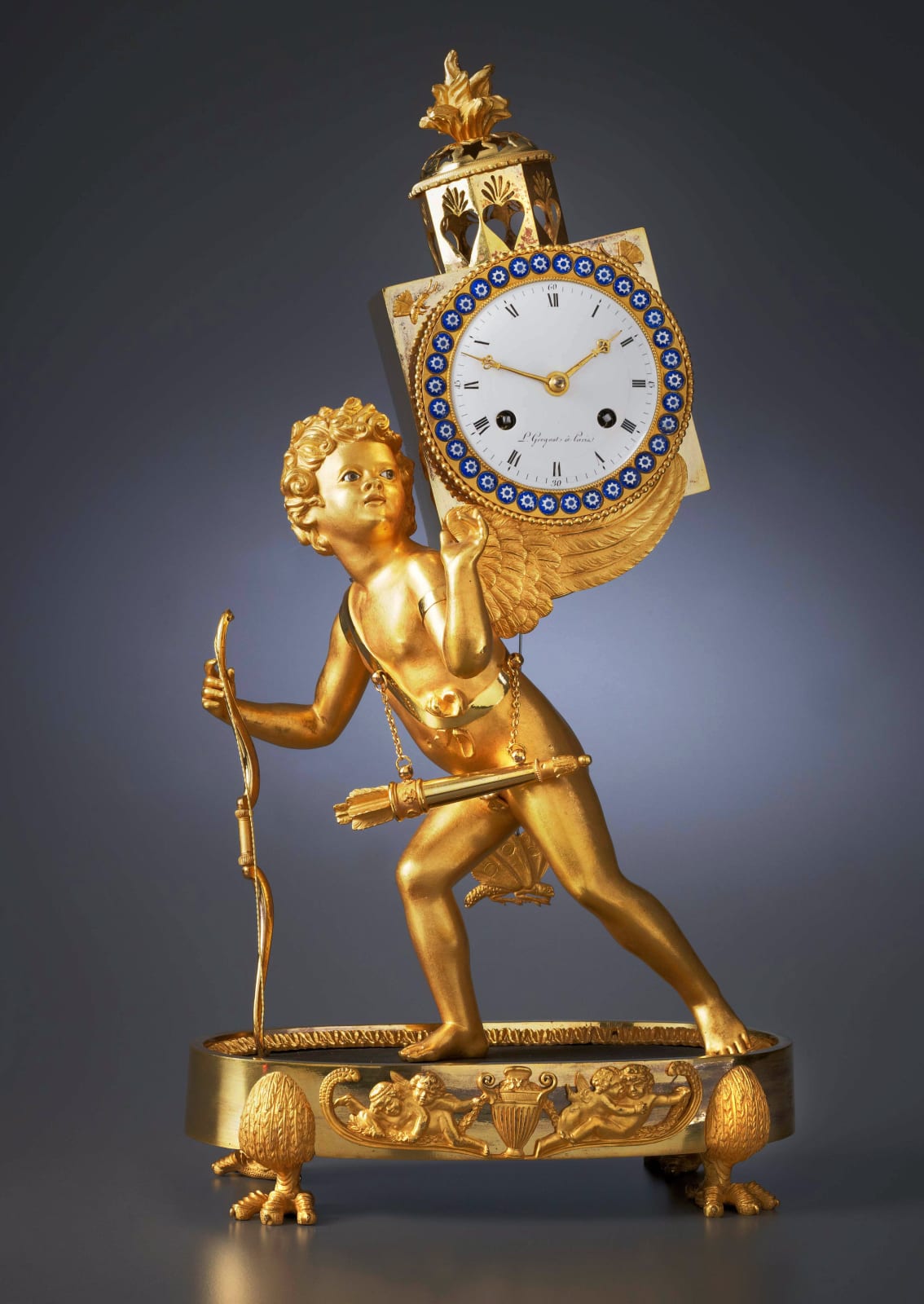L. Grognot
Literature
Pierre Kjellberg, "Encyclopédie de la Pendule Française du Moyen Age au XXe Siècle", 1997, p. 447, pl. D, illustrating a very similar clock case but with a patinated bronze Cupid. Elke Niehüser, "Die Französische Bronzeuhr, Eine Typologie der Figürlichen Darstellungen", 1997, front cover showing a detail and p. 129, colour pl. 210 and p. 230, pl. 658, illustrating an almost identical gilt bronze clock signed on the dial Pinart à L'Orient. "Musée François Duesberg" undated catalogue, p. 38, illustrating an almost identical clock case signed à Paris on the dial.
An extremely fine Empire gilt bronze mantel clock 'à la lanterne magique' of eight day duration, the white enamel dial signed L. Grognot à Paris with Roman and Arabic numerals and blued steel hands for the hours and minutes. The movement with anchor escapement, silk thread suspension, striking on the hour and half hour, with outside count wheel. The case with beaded bezel with blue enamel and gilt rosettes set into the front of a magic lantern with domed top pierced with stars and hearts and surmounted by a flaming torch, the lantern with swinging pendulum with butterfly-shaped bob, carried on the back and supported by the wings of a striding Cupid with enamel eyes carrying a quiver of arrows and bow, standing on an oval plinth, the frieze cast with a vase flanked by pairs of sleeping and playing winged putto, on feathered eagle claw feet
Paris, date circa 1800
Height 46 cm, width 24 cm, depth 13 cm.
Several versions of this case model are known including one in the Musée François Duesberg at Mons, which is simply signed à Paris on the dial. Elke Niehüser illustrates another signed Pinart à L'Orient, while the model illustrated in Kjellberg bears no name at all. The present example is signed Bichon which relates to the retailer Louis Bichon, a marchand-horloger who Tardy records as working 1785-1806 at Moulins, Allier in the French Massif Central.
While a number of early nineteenth century mantle clocks feature Cupid carrying a clock drum on his back the present model is almost certainly derived from earlier prints and drawings of the travelling lanternist as he journeyed from one village to another. Statuettes were also made of these itinerant showmen; some were modelled in metal while others were made from porcelain such as those by the Meissen factory. In general the lanternist would carry his magic lantern upon his back and possibly a musical instrument to announce his arrival or for use during his illusionary performances. These shows included a range of slides from comical images to topographical views; a popular performance during the late eighteenth century was the phantasmagoria in which images of ghosts, skeletons or strange creatures were projected onto a screen. The age of the travelling lanternist came to an end once toyshops began selling comparatively cheap lanterns for home use.
The magic lantern, also first known as the optical lantern, was invented during the mid seventeenth century most probably by the Dutch scientist Christiaan Huygens (1629-95). It was essentially the earliest form of slide projector, consisting as here of a domed top and rectangular lightproof box in which a candle or oil lamp was placed. In front of this a slide or slides were fitted as well as lenses so that a single or even moving image could be projected on to a screen (usually a sheet or white wall). The design of the present case model however substitutes the projection lens for a clock dial, which introduces a very different meaning to other more decorative Cupid clocks of the same era. In this instance Cupid, with his piercing brightly enamelled eyes avoids looking at the viewer but instead points his finger toward the clock dial. In this respect the imagery can be read in the same way as the images that were projected by the magic lantern, i.e. that Time or possibly Love itself is merely an illusion. Further references to Love are provided by the pierced hearts around the lantern top and surmounting flaming torch.
